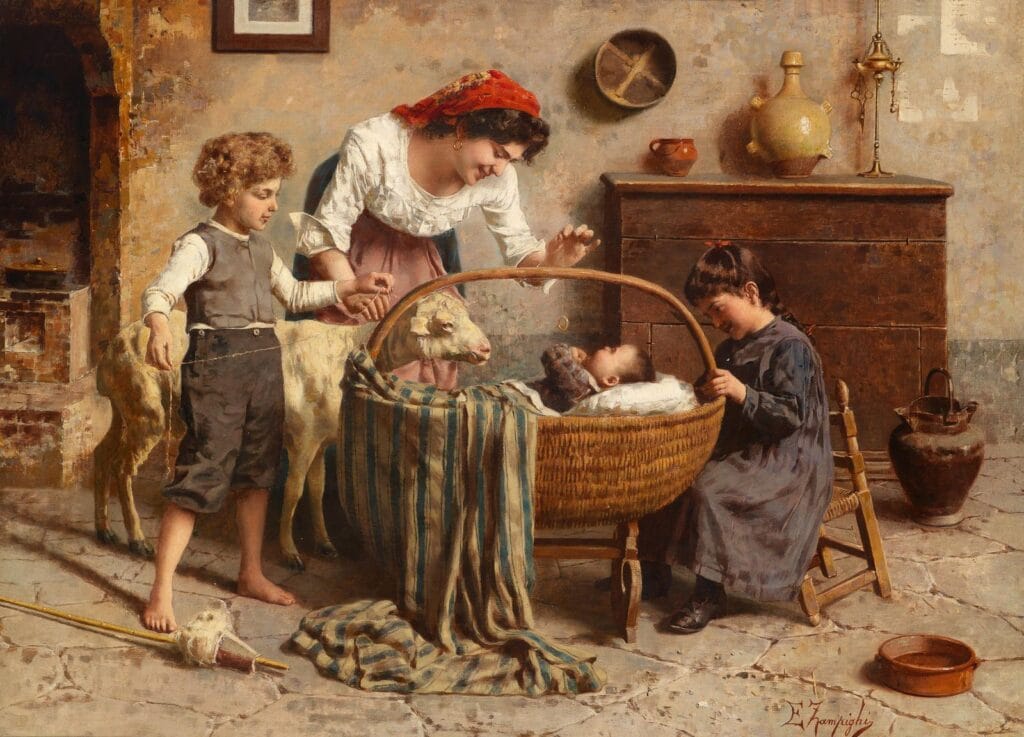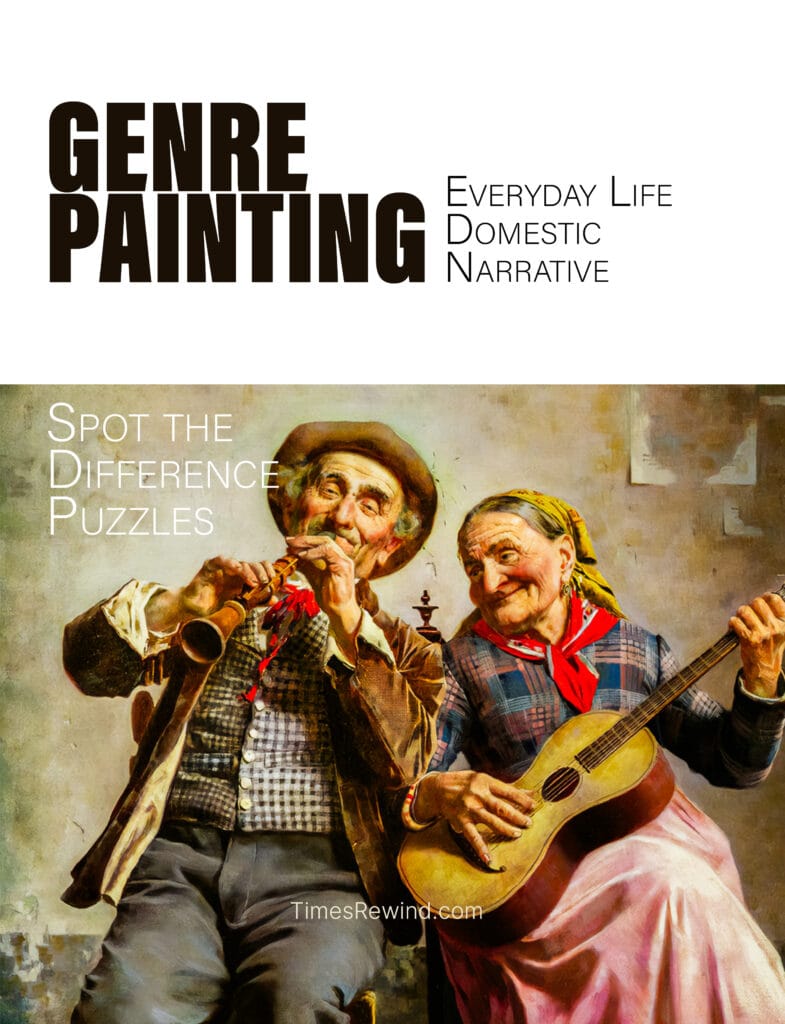Table of Contents
Overview: Come to Me
Eduardo Zampighi’s Come To Me (painted c. early 1900s) offers a glowing glimpse into the intimacy of Italian domestic life. Known for his focus on everyday scenes, Zampighi weaves together love, family, and faith in a composition that radiates warmth. Unlike the grandeur of history paintings, this canvas draws its strength from the ordinary, celebrating the first steps of a child as if they were the most important event in the world.
In this rustic interior, a barefoot toddler, supported by a young mother, takes tentative steps toward an awaiting grandmother. Beyond the doorway, children play outdoors in the sun, while chickens wander freely at the family’s feet. The scene is rich in detail, but its emotional core is universal: the cycle of generations, bound together in love and tradition.
For quick readers, the message of Come To Me is clear. This is not just a family portrait but a celebration of the values that endure across time—tenderness, continuity, and the simple joy of being together.
About the Artist
Eduardo Zampighi (1859–1944) was an Italian painter born in Modena, a city long celebrated for its cultural and artistic traditions. He studied at the Accademia di Belle Arti of Modena under Antonio Simonazzi, and later continued his training in Rome. Although Zampighi was awarded prizes for history painting, it was genre art that became his true calling.
Zampighi developed a distinctive reputation for his cheerful depictions of Italian peasant life. His paintings often feature families gathered around food, children playing, or musicians entertaining in village squares. Drawing inspiration from Dutch Golden Age genre painters such as Vermeer and Metsu, as well as Italian Realists, Zampighi combined precise draftsmanship with sentimental storytelling. His works gained widespread popularity in Europe and were exported to international markets, where buyers admired their blend of technical mastery and heartwarming subject matter.

The Story Behind the Painting
At the heart of Come To Me lies a story as old as humanity itself: the nurturing of a child by the guiding hands of family. The baby, small and unsure, leans forward toward a grandmother whose arms stretch out in welcome. The young mother, bending protectively, acts as the bridge between new life and ancestral wisdom.
Painted during a period of social transformation in Italy, the work echoes nostalgia for rural traditions. By the late 19th and early 20th centuries, industrialization and urban migration were reshaping the country. Zampighi’s art preserved the charm of agrarian life, ensuring that images of hearth and home continued to resonate with audiences facing rapid modernization.
The inclusion of sacred imagery on the wall—a Madonna and Child—draws a connection between the divine and the domestic. Just as Mary nurtured Christ, so too do ordinary mothers and grandmothers nurture the children of their homes. In this way, Zampighi elevates a humble moment to something almost sacred.
Composition and Subjects
Figures and Actions
The child is at the center of the composition, yet it is the grandmother’s posture that commands emotional weight. Kneeling low on the stone floor, she embodies both humility and joy. Her wrinkled hands, stretched open, seem ready to embrace not only the child but also the continuity of her family’s future. The mother bends gracefully, her colorful headscarf linking her visually to the older woman and symbolizing the generational thread.
Objects and Setting
Zampighi fills the interior with meaningful detail:
- Earthen jugs and pottery on the shelves, markers of daily sustenance.
- A scale and kitchenware that remind us of labor and balance.
- A religious print and sacred image anchoring the scene in faith.
- Chickens and a small chick scratching the floor, reinforcing the natural rhythms of rural life.
Even the play of light across the worn stone tiles adds to the authenticity, inviting the viewer to step into a home that feels lived in and loved.
Hidden Meanings
The doorway opens to children at play, forming a visual bridge between the immediate moment of the toddler’s first steps and the larger rhythm of community life. This clever device suggests that every stage of childhood, from infancy to outdoor games, is part of a seamless cycle of growth.
The painting is layered with symbolism: family as the cornerstone of society, faith as the anchor of daily life, and joy as the bond that unites generations.
Art Style and Techniques
Zampighi worked in oil with remarkable technical control. His brushstrokes combine fine detail in faces and clothing with broader, impressionistic handling in the background. The textures of fabric, feathers, and stone are vividly rendered, while the figures glow with lifelike warmth.
His palette favors warm earth tones—ochres, browns, reds—balanced by cooler blues and greens. This combination creates harmony and draws attention to the human figures, ensuring that emotion remains the focal point.
Zampighi’s art was deeply rooted in the European tradition of genre painting, a lineage that included Dutch masters like Gerard ter Borch and Gabriel Metsu, Flemish painters such as David Teniers the Younger, and Italian contemporaries like Gaetano Bellei. Yet unlike some genre painters who emphasized humor or moral lessons, Zampighi specialized in sentiment—capturing laughter, music, and tender family life.
Comparisons with Other Genre Painters
- Dutch Golden Age Influence: Like Vermeer and Metsu, Zampighi uses domestic interiors as a stage for intimate human interactions. Yet while the Dutch often embedded moral commentary, Zampighi emphasizes affection and continuity.
- Italian Peasant Scenes: His contemporary Gaetano Bellei painted similar rustic interiors but with greater dramatic flair. Zampighi, in contrast, leaned toward softness and sentimentality.
- Northern European Contrast: Artists like Jan Steen depicted lively, chaotic households, sometimes satirizing excess. Zampighi, however, offered harmony—his peasants live not in disorder but in affection and balance.
By situating Come To Me within this tradition, we see how Zampighi both inherited and reshaped genre painting for his time.
Featured in Our Collection
Come To Me is proudly featured in our Genre Painting Spot the Difference Puzzle Flipbook. Its abundance of detail—every jug, feather, and gesture—translates beautifully into a puzzle format. The doorway alone, with its playful figures, offers countless points of discovery.
By engaging with this painting as a puzzle, players are invited to slow down, notice hidden nuances, and appreciate Zampighi’s craftsmanship in ways that traditional viewing might overlook. Our digital flipbooks preserve these masterpieces in high resolution, combining classic art with interactive play—a union of culture and creativity.
Come to Me: First Steps, First Hugs, Forever Love
The enduring power of Come To Me lies in its universality. Across centuries and cultures, the simple act of a child taking first steps has symbolized both vulnerability and hope. Zampighi captures this moment with such tenderness that it transcends time. His painting is a call to cherish the ordinary, to honor the bonds of family, and to find beauty not in grand gestures but in daily life.
Through his brush, Zampighi reminds us: love, faith, and continuity are the true masterpieces of human existence. family, love, and the beauty of ordinary days.




